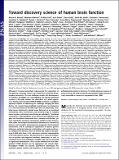Toward discovery science of human brain function
Author(s)
Gabrieli, Susan
DownloadBiswal-2010-Toward discovery sci.pdf (744.3Kb)
PUBLISHER_POLICY
Publisher Policy
Article is made available in accordance with the publisher's policy and may be subject to US copyright law. Please refer to the publisher's site for terms of use.
Terms of use
Metadata
Show full item recordAbstract
Although it is being successfully implemented for exploration of the genome, discovery science has eluded the functional neuroimaging community. The core challenge remains the development of common paradigms for interrogating the myriad functional systems in the brain without the constraints of a priori hypotheses. Resting-state functional MRI (R-fMRI) constitutes a candidate approach capable of addressing this challenge. Imaging the brain during rest reveals large-amplitude spontaneous low-frequency (<0.1 Hz) fluctuations in the fMRI signal that are temporally correlated across functionally related areas. Referred to as functional connectivity, these correlations yield detailed maps of complex neural systems, collectively constituting an individual's “functional connectome.” Reproducibility across datasets and individuals suggests the functional connectome has a common architecture, yet each individual's functional connectome exhibits unique features, with stable, meaningful interindividual differences in connectivity patterns and strengths. Comprehensive mapping of the functional connectome, and its subsequent exploitation to discern genetic influences and brain–behavior relationships, will require multicenter collaborative datasets. Here we initiate this endeavor by gathering R-fMRI data from 1,414 volunteers collected independently at 35 international centers. We demonstrate a universal architecture of positive and negative functional connections, as well as consistent loci of inter-individual variability. Age and sex emerged as significant determinants. These results demonstrate that independent R-fMRI datasets can be aggregated and shared. High-throughput R-fMRI can provide quantitative phenotypes for molecular genetic studies and biomarkers of developmental and pathological processes in the brain. To initiate discovery science of brain function, the 1000 Functional Connectomes Project dataset is freely accessible at www.nitrc.org/projects/fcon_1000/.
Date issued
2010-02Department
Massachusetts Institute of Technology. Department of Brain and Cognitive Sciences; McGovern Institute for Brain Research at MITJournal
Proceedings of the National Academy of Sciences of the United States of America. (PNAS)
Publisher
National Academy of Sciences (U.S.)
Citation
Biswal, B. B. et al. “Toward discovery science of human brain function.” Proceedings of the National Academy of Sciences 107.10 (2010): 4734-4739. Web.
Version: Final published version
ISSN
0027-8424
1091-6490